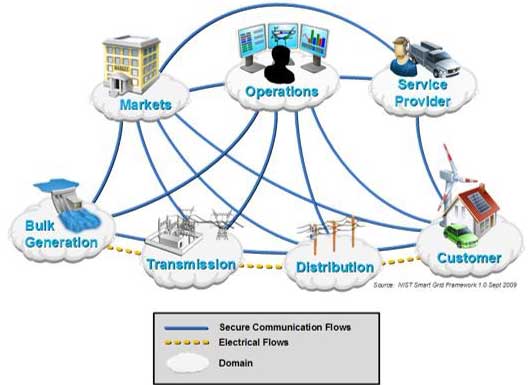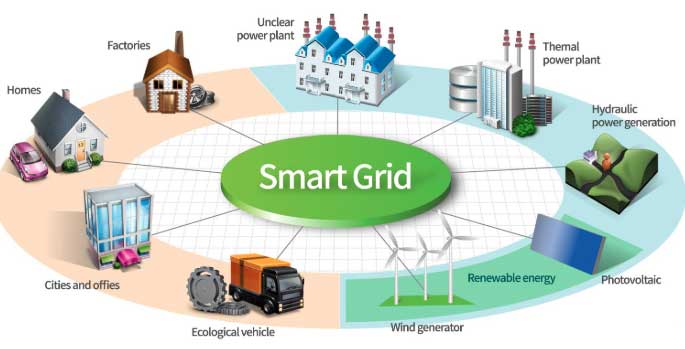Smart grids represent the future of efficient and sustainable energy management. By integrating advanced technologies like SCADA, IoT, and machine learning, smart grids can optimize electricity production, minimize wastage, and improve reliability across power systems. With real-time monitoring and automated fault-clearing capabilities, smart grids not only enhance energy distribution but also reduce operational costs, power outages, and environmental impact. This article explores the key features, benefits, and potential of smart grid technology in modern energy systems.
An electrical grid refers to a system where all the electricity generated from the country’s power plants is collected and then distributed to different areas based on their requirements.
There is no alternative to this for easily and efficiently monitoring a country’s power system. During critical times or blackouts, quick decisions can protect the country’s equipment and minimize damage.
For example: If we considered that the electricity produced from Dinajpur’s Barapukuria Thermal Power Plant would only be used by the people of Dinajpur and surrounding areas, some amount of electricity would remain unused, as the demand in this region is not that high. At that time, the unused electricity would neither be utilized nor sent to other regions.

In this way, regions with higher electricity demand but fewer power plants would face significant shortages. The inter-connected grid system has solved this problem. The term “Smart Grid” has been introduced with the goal of making the grid smarter. This article will discuss the following 8 topics:
- What is a Smart Grid Technology?
- How is a Smart Grid different from a conventional grid?
- What is needed to make a system smart?
- Self-healing or automatic fault resolution.
- Smart Grid in terms of generation.
- Smart Grid in terms of distribution.
- The benefits of using a Smart Grid.
- Smart Grid in Bangladesh’s context.
What is a Smart Grid Technology?
The term “Smart Grid” includes the word smart, indicating that it will be somewhat different from a conventional grid.
A Smart Grid is a network or system where two-way communication is established between the supplier and the consumer, ensuring efficient electricity usage through real-time information exchange. It is powered digitally, allowing users to monitor their electricity usage from home. It helps prevent blackouts and protect household appliances from minor faults.
In simple terms, it is a computerized electrical communication network that integrates the activities of all connected producers and consumers with the aim of delivering affordable, safe, and sustainable electricity to consumers’ doorsteps.
Through net metering, a consumer can also participate directly in electricity production. They can generate electricity for their own needs and sell any excess to the grid for a profit. Since two-way communication is possible, the consumer in this case is referred to as a “Prosumer” (PROSUMER = CONSUMER + PRODUCER), as they are both a consumer and a producer.
How is a Smart Grid Technology different from a conventional grid?
| Existing Grid | Smart Grid |
| Electromechanical | Digital |
| One-way communication | Two-way communication |
| Centralized generation | Distributed generation |
| Few sensors | Sensor throughout |
| Manual monitoring | Self-monitoring |
| Manual restoration | Self-healing |
| Failures and blackouts | Adaptive and islanding |
| Limited control | Pervasive control |
| Few customer choices | Many customer choices |
What is needed to make a system smart?

- Smart Meter
- Smart Home
- Smart Generation System
- Smart Distribution System
- Smart Substation
- Customer participation
- Connection of green energy sources to the grid
The four conditions to fulfill for a Smart Grid Technology
Handling the Load:
The total grid load doesn’t remain the same; it changes every second. During off-peak or peak times, the Smart Grid can advise consumers to use less electricity for a while.
Demand Response Support:
Automatically informs consumers how they can reduce their electricity bill by optimizing usage, thereby preventing energy waste.
Decentralization of Power Generation:
Through decentralization, users can generate electricity based on their needs. At this point, a consumer can be considered a prosumer.
Ensuring Reliable Electricity:
The system should run in a way that ensures a consumer can rely on electricity without experiencing power shortages when needed.
Smart Grid in terms of generation

Let’s assume the daily electricity demand of a region is 50 megawatts, which is supplied by the neighboring area’s power plant. Since the demand is not constant, does the excess electricity go to waste?
Answer: No, based on the demand at any given time, the smart grid identifies the demand and instructs the generating plant to produce accordingly, thus preventing wastage and avoiding unnecessary costs.
With the help of SCADA, the demand in any area is identified and production is adjusted accordingly, so that there is no unnecessary wastage, and only the required amount is produced. This greatly helps in increasing the reliability of the system.
All substations communicate to assess the demand before production begins. This is done automatically, making load sharing more efficient and preventing load shedding.
Smart Grid in Distribution
The load used by any customer at any given moment is monitored, and the substation of that area communicates the load capacity to the National Load Dispatch Center (NLDC), allowing overall generation to be completed accordingly.
Sometimes, due to insufficient fuel or maintenance work causing several units to shut down, load shedding becomes necessary.
If the smart grid system can be applied in the country, it would be possible to control the overall electricity situation of the country, monitor customer demand, and automatically clear faults in real-time from the control room. Additionally, the process of importing electricity from India and Nepal can be managed more efficiently.
Self-Healing / Automatic Fault Clearing
When talking about the smart grid, the term Self-Healing (SELF HEALING) must be used. This refers to the grid’s ability to automatically disconnect a faulty line/phase/ground to protect the main line, and reconnect as soon as the fault is cleared without the help of a lineman.
On the computer monitor, the fault can be seen, along with the measures the system took to minimize it.
If any issue arises in a generation plant, it can be disconnected from the grid to protect the grid. Synchronizing each generating plant with others is also smoothly done through the smart grid.
As a result, the reliability of the system increases, and customers are more interested in using electricity.
With the help of IoT and machine learning, this smart grid system can be further improved, enabling uninterrupted power supply to citizens and reducing electricity wastage, which would lead to economic benefits.
Advantages of Using a Smart Grid
- System losses will decrease.
- Energy loss will be reduced. With digital meter reading, tampering will stop, and illegal connections can be easily disconnected.
- Maintenance costs will decrease.
- Power factor correction charges will be reduced, so customers won’t have to pay fines.
- Carbon dioxide emissions will decrease.
- Operational costs will decrease.
- The frequency and duration of power cuts will decrease.
Conclusion:
Smart grid technology offers a transformative approach to managing electricity demand and supply, paving the way for a more reliable and sustainable energy future. By reducing energy losses, improving load management, and enabling seamless integration with renewable energy sources, smart grids can revolutionize how we produce, distribute, and consume electricity. As more countries adopt this technology, the path toward a cleaner, more efficient
1. What are some examples of smart grids?
Smart grids are being implemented across various countries to improve energy efficiency and reliability. Some notable examples include:
United States: The Pacific Northwest Smart Grid Demonstration Project focuses on enhancing energy management with real-time monitoring and renewable energy integration.
Europe: The EcoGrid EU project in Denmark integrates wind energy with real-time pricing systems to balance supply and demand.
Japan: The Kansai Electric Power smart grid utilizes advanced metering infrastructure (AMI) for efficient energy distribution and monitoring.
2. What is a smart grid system project?
A smart grid system project involves upgrading traditional power grids with digital technologies like sensors, automated control systems, and two-way communication networks. These projects typically focus on real-time monitoring of energy usage, reducing wastage, integrating renewable energy sources, and automating fault detection to improve overall grid efficiency.
3. What is a smart grid in the power system?
A smart grid in a power system refers to a modernized electrical grid that uses advanced communication and control technologies to enhance the generation, distribution, and consumption of electricity. Smart grids enable real-time monitoring, demand response, automated fault detection, and integration of renewable energy sources, making power systems more efficient and reliable.
4. What are the advantages of a smart grid?
Smart grids offer numerous advantages, including:
Improved energy efficiency by reducing wastage and optimizing power generation.
Enhanced reliability through automated fault detection and real-time monitoring.
Lower operational costs by reducing maintenance and improving load management.
Environmental benefits such as reduced carbon emissions and better integration of renewable energy sources.
Reduced power outages due to better fault detection and quicker recovery.
5. What are the key features of a smart grid?
Two-way communication between utility companies and consumers for real-time energy management.
Automated fault detection and self-healing to improve grid reliability.
Integration of renewable energy sources like wind and solar into the grid.
Advanced metering infrastructure (AMI) for accurate energy usage data.
Demand response systems that adjust power supply based on real-time demand.
6. What are the different types of smart grids?
Smart grids can be categorized based on their applications and scope, such as:
Residential Smart Grids: Focused on optimizing energy usage for households through smart meters and home automation systems.
Commercial Smart Grids: Designed for industrial and commercial energy consumers, enabling demand response and energy efficiency improvements.
Microgrids: Localized grids that can operate independently from the main grid, integrating renewable energy sources and ensuring power during outages.
Utility-Level Smart Grids: Large-scale grids used by utility companies to manage power distribution across vast areas, often integrating renewable sources and advanced monitoring systems.



